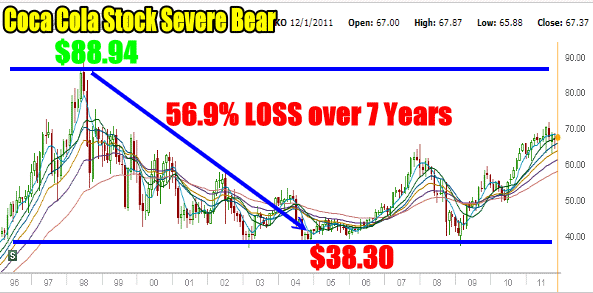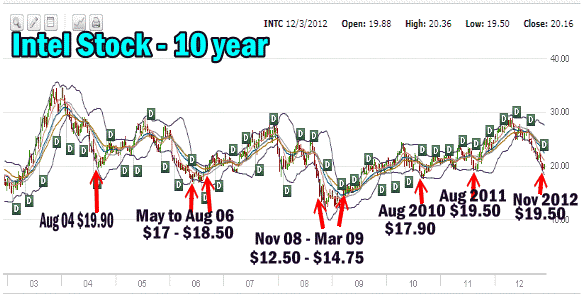Intel Stock has been in my online portfolio since 2010. But Intel Stock has been in my personal portfolio for two decades. When a great stock falls from favor, investors both retail and institutional naturally worry. Recently Intel announced a bond issue to be used for buying back shares and other undisclosed business activities. This 6 billion dollar issue ranged from 5 to 30 years. A lot of investors wondered about this bond issue, after all Intel has little debt and a wide moat of cash. With historic low-interest rates it makes a lot of sense to issue bonds and with Intel stock down it’s a great time to buy back shares. This not only increases share holder value but decreases the capital outlay for dividend payouts. This is an excellent move on the part of Intel and typical of a company that thinks outside the box. It is this type of thinking that keeps me Put Selling against Intel Stock.
Each day my inbox is filled with emails from investors worried about Intel Stock. Many who bought in at $24 and above or sold puts at $23 and above have sold their positions for large losses.
I Like Intel Stock
In investing the plan is to buy great companies when they are cheap, undervalued and under appreciated. Intel Stock is now in this camp and a lot of investors are bailing out. In my opinion Intel Stock is an excellent buy anywhere below $20.00. My Intel Stock trades certainly bear out my stance on Intel Stock. My Intel Stock portion of my online portfolio is now the largest of all my stock holdings. I am holding naked puts from $15 to $26 and 2000 shares of Intel stock with covered calls that could be exercised in December. If they are I will be selling more naked puts. I like Intel Stock and I am always consistently using a strategy.
With Intel Stock Strategy Is Important
I have written a lot of articles on the importance of strategy and the importance of having a plan. If both are in place I find there is no need to worry about any of my positions. The plan should be to get a great bargain on a great stock. Intel Stock is now in the bargain bin. It could go lower making it even more attractive, but I have no way of knowing how low Intel Stock may or may not go. This is why I do Put Selling throughout a decline.
My Strategy On Intel Stock
My strategy on Intel Stock was Put Selling as the stock fell. I then roll those puts forward, staying ahead of assignment and dividend payouts. Each time I roll I reduce the number of puts sold at that particular put strike and free up more capital. As more capital is freed up I then can sell more naked puts at lower strikes which basically averages my position lower into Intel Stock.
On lower strike puts, I accepted assignment and then sold in the money covered calls to get exercised out of those shares. This then frees up more capital for selling additional put strikes out of the money.
All of this works to reduce my position in Intel Stock, adds extra income to my portfolio and eventually I may accept shares at much lower prices. If Intel Stock recovers over the next 6 months then many of the naked puts I hold will of course expire out of the money and that’s fine to. The goal is to keep generating income and work my way lower in the stock.
I love this strategy and have used it for decades on stock. But many of the emails I have received are from investors who dumped shares or bought to close naked put positions for losses and want to “get their losses” back. What many investors did not follow is two important rules of put selling.
Put Selling Rule Number 1
If the collapse of Intel Stock has taught anything to put sellers it is that rule number one must always be adhered to. That rule is to never sell puts on stocks you do not want to own.
Put Selling Rule Number 2
The second rule is for put sellers who do NOT want to own shares in a stock. Never sell puts against a declining stock. It is foolish to sell against a stock that is declining. A lot of investors sell against a declining stock because put premiums are so attractive. They are attractive because the stock is falling. Always sell puts against a rising stock when you do not want to own shares.
These two rules are basic and simple but are not followed by a lot of investors interested in selling naked puts. When engaged in Put Selling against a stock that is declining many investors convince themselves they would own shares. But when a stock falls 15% or more they suddenly decide they do not want the shares after all.
Put Selling And Getting Out Early
It is always after the decline becomes steeper that investors who did Put Selling look for ways to get out and break-even. Unfortunately the time to get out was when the stock had fallen to the original put strike sold. The steeper the decline becomes the more difficult a rescue strategy is. Steep declines take longer for rescue strategies to work and many require additional capital to be put at risk.
It is very important to successful investing to understand the type of investor you are. In this article I wrote I discussed the importance of knowing the type of investor you are. If you are seeking income and never want to own shares or certainly rarely want to own shares, you have to take that into account when Put Selling. In my instance I love the companies I am Put Selling against. I would own each of them in a moment if assigned and you can tell this from looking at the stocks and the trades I am holding. Even those that I say I do not want shares in, I would still own if I was assigned.
Put Selling Advantage
Put Selling against stock I would own is a huge advantage because I can use strategies to keep bringing in income, reduce capital at risk, use more capital, adjust, add some twists to every single trade I do because I have a very long-term outlook. Going back to Intel Stock, I have been in this company for decades and have been through many declines. Yet the returns have been double-digit year after year.
Put Selling The Coca Cola Stock Loss
My Coca Cola Stock trades during the years from 1998 to 2003 are another great example of long-term strategies. Coca Cola Stock was whipsawed continually during that time period but was in a long-term decline. In the end it lost more than 50% of its value. This is a link to a full article on Put Selling an over-valued stock which looks at Coca Cola Stock over this time period which you may find interesting.
Over a 7 year period from 1998 to 2004 Coca Cola Stock lost 56.9% of its value. During this period I sold naked puts, had many fall in the money, got assigned on some naked puts, sold covered calls, sold more puts, rolled puts, reduced capital at risk at higher put strikes and increased capital at risk in lower puts. Through it all I earned double-digit returns annually, but it required a solid strategy, planning, consistent implementation of rolling and selling in the money covered calls and most importantly, additional capital to be placed at risk.

Capital At Risk When Put Selling
If an investor cannot put more capital at risk into a stock, then they must change their strategy being used and their outlook on their investing method. If no additional capital is to be made available, then you should not be Put Selling within a declining stock, which goes back to my comments about knowing the type of investor you are. Financial Planners and Advisors all talk about allocation models for investing. I too believe in allocation models. I use 40% in stocks, 30% in bonds and 30% is in cash. That is my model. But when it comes to that 40% in stocks I may have 25% of it in just one stock. I believe in Warren Buffettt’s approach. I put my capital to work in what I trust and believe will provide the best return. To that end from 1998 to 2004 I ended up with 30% of my entire stock portfolio dedicated to Coca Cola Stock and I ended up by 2004 with an average break-even price of $18.70 and was holding 5500 shares. In 2007 these shares were all sold for $60.00 through a covered call strategy.
Consider then that from 1998 to 2004 I earned double digits each year on Coca Cola Stock. Then consider that I made enough income through that period that my 5500 shares by the end of 2004 were at a break-even of $18.70 and were then sold for $60.00. This resulted in tripling 25% of my stock portfolio.
This is why I like Put Selling against stocks that I would own. There is a significant advantage for this method.
Put Selling And Avoiding Assignment – 13 Rules
But for those investors who do not want to own stock I suggest once again reading this article concerning the 13 rules for Put Selling and avoiding assignment.
Intel Stock 10 Year Chart
While Intel Stock has not experienced the severe bear market like Coca Cola stock went through, Intel Stock has seen lots of downturns. The 10 year chart below shows the prime areas where I did significant Put Selling. In other words, these low points were when I more than doubled the capital I placed at risk of assignment in Intel Stock.
Many people ask me how I managed to grow my capital so quickly. It is because I have a lot of faith in the stocks I put sell against and because:
A) I commit almost all of my capital to stocks when the world looks like it is about to end. Bear markets are a phenomenal time to buy stocks ultra cheap and sell them within a year or two for what is almost always a doubling of income. You can view the 2009 stock trades I did through this link. For Canadian investors here are the stock trades I did in 2009 with Canadian Stocks.
B) I increase my capital on stocks that I like but are out of favor and increase the number of Put Selling contracts I enter into.
In the chart below you can see the 10 year chart in Intel Stock. I have marked the price ranges when I more than doubled my capital at risk.

Intel Stock 10 Year Chart
If you look at my Intel Stock trades for 2012 you can see that I increased the capital at risk in Intel Stock starting this past October when Intel Stock began to collapse. As I have no way of knowing how deep the collapse will be I start small and increase the capital as the stock keeps falling. Now that it looks like it may have bottomed at $19.20 to $19.50 I have been Put Selling the $19.00 strike and even did some leap puts two years out at the $15 put strike on Intel Stock.
The capital at risk has gone up to $165,000 in Intel Stock. You can clearly see that I am applying more capital to my Intel Stock trade. For investors who do not want to own shares, but did not close as soon as the stock fell to the put strike price they sold, it is difficult to rescue a trade if naked puts are deep in the money and no additional capital will be used. It then becomes a game of rolling further out in time. Again, many investors do not want to roll very far out which makes rescue efforts even more difficult.
This is why it is so important to understand your goal when Put Selling. I have committed over $165,000 now to Intel Stock. This could take months to years for a recovery in the trade. I am very content to keep rolling and consistently applying my strategies no matter the time frame. But for investors who:
A) Did not want to actually own shares
B) Do not want to commit more capital
C) Do not want to roll out more than a couple of months
rescuing their trades and turning them to profitability is difficult and requires an investor to be willing to trade and use technical analysis to trade back and forth within the stock as it moves up and down and keep buying back the naked puts sold and selling them again. This trend following strategy is one of the few strategies that can be used to try to repair a loss in Put Selling that has ended up deep in the money but it takes time and work to complete an adequate recovery.
That strategy is beyond the scope of this article and will need its own separate article, but suffice to say, the importance of understanding your goals and objectives and not changing midway through a trade is important for a successful outcome.
Summation of Intel Stock Pullback
Understanding the type of investor you are or want to be is paramount to consistent success when it comes to stock and option investing. As to Intel Stock, it may fall lower or Intel Stock may move sideways for months, but I like Intel Stock as you can obviously see from all my trades.
Intel is a great company, that consistently increases its dividend and most important, it is a company that thinks outside the box. Like all companies they make mistakes, but in the history of great companies, Intel is one that stands out not only as a leader but as an innovator and that is the type of company I like selling puts against.
Internal Intel Stock Links
Members Only Articles On Intel Stock
Review 2012 Intel Stock Trades
Review 2011 Intel Stock Trades
Review 2010 Intel Stock Trades
All Intel Stock Posts With Excerpts
External Intel Stock Links

